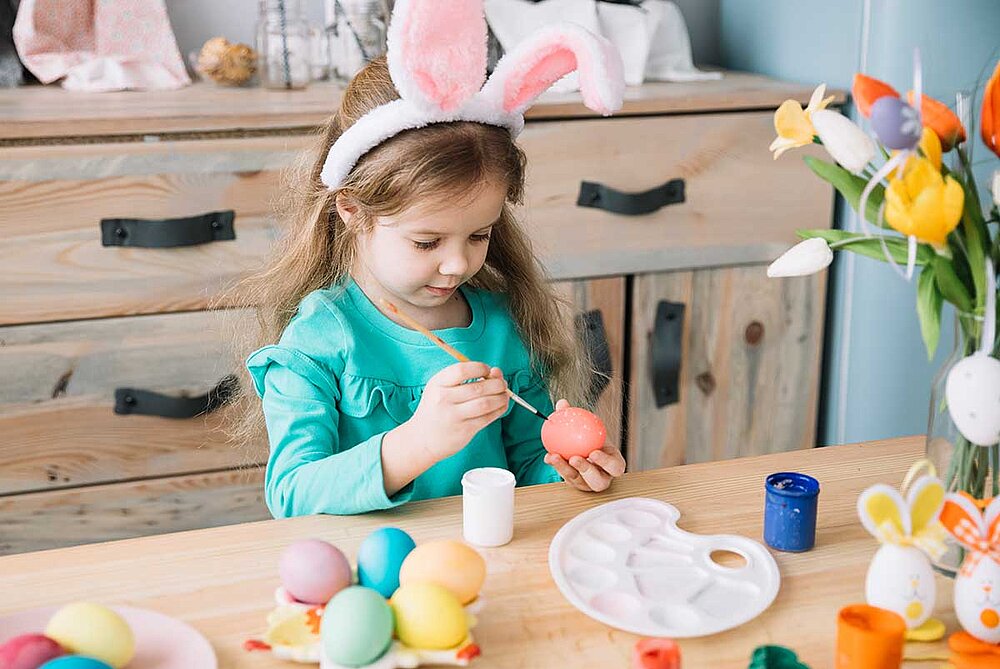Why Easter is creative fun

On the eggs, get set, ... go! Easter rabbit and his friends are already in the starting blocks: Easter will soon be here! We show why such celebrations are joyful for children from all cultural backgrounds.
Easter is one of the most important Christian festivals, celebrating the resurrection of Jesus - and a time when family and friends come together, celebrate with each other and welcome spring. At globegarden Easter plays a supporting role in the annual routine. Although we have children with all kinds of cultural backgrounds, we are convinced that experiences with traditions convey a feeling of security and safety. This is more important than ever for the youngest members of our society, especially in these times when everything is changing so quickly and only limited reliance can be placed on many things - regardless of their origins.
Spring, joy, bright colors
Above all, the time before Easter is characterized by fun, lightness and lots of creativity. Especially as it’s greening and blooming outside again, it’s a joy to decorate the rooms and bring color into life with great handicrafts, decorated branches and - of course - colorfully painted eggs. If you need some inspiration to make Easter a truly exciting and magical celebration for your children at home, we have put together a few tips and suggestions for you here.
Egg blowing made easy
It takes a bit of skill, patience and thick cheeks to blow out the eggs for the Easter bush. But with the right technique it works much better. In addition, you should take a few important precautions:
- There is always some risk of salmonella when handling raw eggs. Therefore, clean the eggs carefully with detergent under hot water before blowing them out.
- For blowing out, first pierce the egg on both sides with a sewing needle and then carefully enlarge the holes with a thicker needle. The bottom hole should always be slightly larger than the top.
- Now hold the egg over a bowl and blow into the smaller hole. Tip: If you poke the yolk with the needle beforehand and “mix” it slightly, the egg is much easier to blow out.
- For even more hygiene, you can also use a drinking straw, a disposable syringe or a special mini pump from the craft store to blow it out instead of directly applying your lips.
- To prevent unpleasant odors from developing, the emptied eggs should be rinsed several times from the inside. To do this, simply place them in a bowl with some vinegar. Once they are full, shake them and give them another good blow. Repeat the process two or three times. Then let them dry well.
- Do not pour the blown out egg mixture away, but make it into delicious scrambled eggs or bake a great Easter cake.
- To hang the Easter eggs, break toothpicks into three pieces, tie a long thread around the middle and carefully insert it into the top opening of the egg so that the little stick hangs crosswise on the inside.
Dye, paint, glue on
Easter eggs are best as colorful as possible - and also, as far as the decoration is concerned, there are no limits to your imagination and that of your children. If you don’t want to use food coloring, you can also color the eggs in a completely natural way: for example, with the decoction of beet (red), red cabbage and blueberries (blue, purple), spinach (green), chamomile, curry or turmeric (yellow), light onions or carrots (orange), coffee or dark onions (brown).
Water-based and acrylic paints, markers, chalk or wax crayons are suitable for painting. Great effects can also be achieved with the napkin technique. Or you can decorate the eggs with dried leaves and flowers and then paint over them. Also nice: Apply patterns to the white eggs with liquid wax or wrap them with twine, then color them, let them dry and then remove the wax or the threads.
To make sure nothing gets broken, it’s best to stick the eggs for crafting on long wooden handles (shish kebabs), which you place over a bowl along with the egg.
After Easter, you can store your little works of art in an egg carton until next year. In this way, a precious collection accumulates over time, which also documents the artistic progress of your little darlings.
Great crafting fun
With Easter decorations, spring moves into the home. Just as popular as decorative is a large bouquet of palm catkins, which, if you do not have your own garden, are available at the florist, but also in many hardware stores (please do not simply cut them off in nature). Decorate the branches with the painted Easter eggs or even with bows made of colored crepe paper.
Since children love handicrafts, you can also make Easter decorative objects with them. From painted kitchen or toilet paper rolls or colored clay paper you can make pretty bunnies, chicks, ladybugs or bees in no time. Or you can collect stones, feathers, moss, twigs or sticks with your children during a walk in nature, glue everything into the lid of a shoebox - and a small Easter mural is ready.
And keep in mind that only solvent-free adhesives should be used for handicrafts with children. This is because volatile solvents can cause headaches and irritation of the respiratory tract. Wallpaper paste is also good for crafts. Cornstarch heated with water is a great glue for paper and cardboard that can be applied selectively with a brush. For safety reasons, superglues should be taboo for children.
The perfect hiding place
The most fun for children on Easter Sunday is, of course, the egg hunt. Parents should make sure that the hiding places are chosen in such a way that they correspond to the respective age of the children and that the nestlings are at the children’s eye level and also look out a little - after all, the search should not end in frustration.
Great hiding places for the little ones are for example:
Indoor: the washing machine, the refrigerator or oven, the sock drawer, winter boots, cooking pots, the laundry basket, the older sibling’s school bag, pillowcases.
Outdoor: the rain gutter, upside down plant pots, behind rain barrels, hedges, the mailbox, the watering can, a birdhouse, knotholes and roots. You can also hang little chocolate eggs on the bushes for motivation. And if your child doesn’t find anything after all, a few hints with “warm” and “cold” are always helpful and welcome.
Popular Easter games
After the egg hunt comes the next pleasure: Outdoor games. This is not only fun for the kids: try it yourself!
Eiertütschen: In this game, which is traditionally celebrated on a grand scale, especially on the Kornhausplatz in Bern, you duel with hard-boiled (!) eggs. Each opponent hits the tip of his own egg on the egg tip of the opponent. Whoever breaks the opponent’s shell gets the other person’s egg.
Egg Run: Most people remember this classic game from their childhood: with a spoon in hand and an egg on it, participants must reach the finish line as quickly as possible. With obstacles you can increase the difficulty level for the adults.
Egg blowing: A blown-out egg is placed on the table. Then everyone blows at the same time. Whoever gets too close to the egg has to blow it away. And whoever has the egg fall down, has lost.
Egg in the mountain: The object of this game is to let the egg rest in its soft bed of sand, flour or salt for as long as possible. To do this, a mountain is piled up and the egg is placed on top. One after the other, all players remove something from the mountain with a teaspoon. The player who causes the egg to tip over loses.

